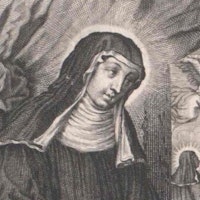The Human Form
Topic: The Natural World
The human form is built into the world structure; indeed, even the cosmos.
Hildegard of Bingen (1098-1179) was a Benedictine abbess and mystic of medieval Germany. She was born into a noble family in Bermersheim vor der Höhe, Germany, and entered religious life at the age of eight. She received a rudimentary education, but at the age of forty-two, she began to experience a series of visions that would shape her life and work.
Hildegard described these visions as "the living light," and they were often accompanied by physical sensations such as heat, cold, and pain. She believed that these visions were a gift from God, and she felt called to share them with the world. She began to write down her visions, and she also composed music and poetry to express her spiritual insights.
Hildegard was a prolific writer, and her works cover a wide range of topics, including theology, natural science, medicine, and music. She is best known for her three volumes of visionary theology: Scivias, Liber Vitae Meritorum, and Liber Divinorum Operum. These works are rich in symbolism and imagery, and they offer a unique perspective on the nature of God, the human soul, and the world.
In addition to her writings, Hildegard was also a gifted musician and composer. She wrote over 70 songs, including the Ordo Virtutum, an early example of liturgical drama. Her music is characterized by its simple melodies and its use of plainchant.
Hildegard was a complex and multifaceted figure, and her work continues to inspire and challenge people today. She was a visionary, a mystic, a writer, a composer, a scientist, and a healer. She was also a woman of great courage and determination, and she used her gifts to make a difference in the world.
Hildegard of Bingen was a remarkable woman who left a lasting legacy. She was a pioneer in the fields of theology, natural science, and music, and her work continues to be studied and appreciated today. She was also a powerful voice for women's rights, and she challenged the patriarchal structures of her time. Hildegard of Bingen was a true visionary, and she continues to inspire us with her courage, her intellect, and her creativity.
Scivias
Wilson, Andrew, editor. World Scripture II. Universal Peace Federation, 2011, p. 143 [Hildegard of Bingen, Scivias].

Hildegard of Bingen
Theme: Natural World


About This Hildegard of Bingen Quotation [Commentary]
Hildegard of Bingen, in “Scivias 1.3: God, Cosmos, and Humanity,” presents us with a vision where the human form is seamlessly integrated into the cosmos. This insight urges us to recognize our profound link with the universe—a connection that is real and present in our very essence. Acknowledging this, we come to see the sanctity of our own form, reflecting the cosmic blueprint.
Hildegard’s words carry the weight of a truth that places humanity within the expanse of cosmic reality. Contemplating our role in this grand expanse invites us to consider our place not as solitary beings but as part of a larger, interconnected existence. This awareness calls us to a life informed by the depth of our connection to the whole, affecting our interactions with the visible and the invisible, and guiding us toward a deeper wisdom rooted in the fabric of the universe.
Richard Rohr, Hildegard of Bingen, Scivias [Excerpted from his commentary]
Hildegard von Bingen’s vision of the Feminine Divine
Additional Hildegard of Bingen Quotes
Resources
Related Quotes
Copyright © 2017 – 2024 LuminaryQuotes.com About Us